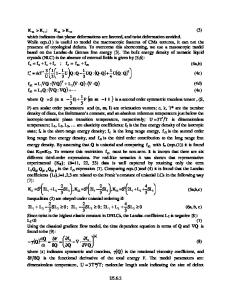Preparation and Characterization of Nanometer-scale Polycarbonate Fibers: Bead Formation
- PDF / 612,444 Bytes
- 6 Pages / 612 x 792 pts (letter) Page_size
- 101 Downloads / 372 Views
D2.6.1
Preparation and Characterization of Nanometer-scale Polycarbonate Fibers: Bead Formation Jamila Shawon and Changmo Sung Center for Advanced Materials, Department of Chemical Engineering, University of Massachusetts Lowell, MA 01854, USA
ABSTRACT
Electrospinning is a superior process compared to other conventional spinning methods for the production of fibers in the sub-micron to nanometer scales. Such fiber membranes have exceptionally large surface areas and small pore sizes. The process requires an electrostatic force, which induces charges on the liquid droplet of the polymer solution or melts and therefore overcomes the surface tension and viscoelasticity forces to create an electrically charged jet. When the jet dries or solidifies, an electrically charged fiber remains, which can be directed or accelerated by the electrical forces and then collected in non-woven fiber membrane or other useful shapes. The present research work demonstrates the electrospinning of polycarbonate solution with solvent mixtures THF (Tetrahydrofuran) and DMF (Di-methyl formamide) to produce nanometer scale polycarbonate fibers. The solvent mixture of THF and DMF was the major parameter for producing nano-polycarbonate fibers along with the formation of byproducts beads. The electrostatic voltage, viscosity and surface tension also showed significant effect on bead formation and bead density. The microstructures of the polycarbonate beads were quantitvely investigated by Scanning Electron Microscope (SEM) and Transmission Electron Microscope (TEM).
INTRODUCTION
Over the few decades, electrospinning process has received tremendous attention because of its ability to generate consistent polymer fibers ranging from 5 nm to 500 nm in diameter [1]. The small diameter polymer fibers with small pore sizes and large surface areas have spread their applications range from the textile industry to medical science, and in the optics and electronics fields [1]. The electrospinning of polymer solutions often results fibers with byproducts beads (Fig.1) and the formation of the beaded nanofibers is influenced by the solution viscosity, net charge density and surface tension [2]. Polycarbonate is a promising thermoplastic material and has been widely used as an injection molded material. Very little research on electrospinning of polycarbonate has been performed that has focused on the fiber formation through selecting the proper polymer solvent system. Our research work focused on the morphology and structure changes of polycarbonate fibers with different solvent mixtures ratios (THF: DMF as 60:40; 70:30 to 100:0 by volume%) at different voltages (from10 to 30kV) and different polymer concentrations (13%, 13.5%, 14 and 15% by weight). The electrospinning experiment of polycarbonate fibers often revealed
D2.6.2
X5000 Figure1: Scanning Electron Micrographs of byproduct beads during electrospinning of polycarbonate fibers. prominent beads as a result of solvent mixture ratios along with other process variables such as spinning voltage, v
Data Loading...











